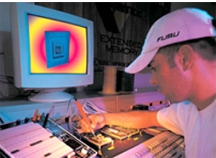
At the Intel International Science & Engineering Fair (ISEF) 2007 in Albuquerque next week, a thrown tube of glue stick stands a very good chance of hitting a Sandian. Labs volunteers will be out in force all week, and Sandia is supporting the event in a number of other ways, say Sandia organizers.
“This is such an important event for Sandia and for education,” says Karen Gillings (3550), who leads a team coordinating the Labs’ contributions. “It shows promising young people that we care about improving the state of science and engineering education in this nation.”
The event begins Sunday and continues through Friday and features science fair projects of some 1,500 precollege students representing 47 countries, regions, and territories — all winners in their regional competitions. The last time Albuquerque hosted ISEF was in 1983.
At least nine 2007 Intel ISEF participants worked at Sandia as interns or have Sandia parents or mentors. (See “Intel ISEF finalists who have ties to Sandia” below.)
Planners and volunteers
Two Sandians have played major roles in getting ready for ISEF since local planning began three years ago. Len Duda (5715) and Ted Wolff (3652) are serving as judging cochairs on the ISEF host committee.
Among New Mexico institutions, Sandia is contributing the largest number of volunteer judges. More than 125 Sandia employees will judge, along with another 700-plus technically trained New Mexicans. The judges will review projects on Tuesday and spend Wednesday talking with ISEF finalists and scoring their projects based on ISEF criteria, says Len.
More than a dozen Sandia ISEF volunteers will perform other critical functions during the event as well.
“I want to let students know there are great, interesting careers in engineering,” says Cole Shaw (6432), who volunteered to give middle and high school students tours during ISEF’s public visitation days. “Science and engineering can change the world, and it’s important to show visiting students what they could achieve.”
Two-week internships
Sandia will offer some ISEF participants an all-expenses-paid two-week internship at the Labs this summer. The goal during ISEF is to get acceptances from 15 students whose projects fare well in ISEF’s 17 judging categories, says Kim Maxwell (3555), ISEF internship project lead.
While they are in Albuquerque, the students will be housed at Menaul High School and assigned to shadow members of the technical staff during the work day. The Labs is gearing up to make the program a rewarding experience for the interns, she says. Watch the Lab News for more.
Event sponsorship
Sandia will offer a $2,500 college scholarship to one ISEF project related to the application of nanotechnology in one of three categories: materials & bioengineering, electrical & mechanical engineering, or chemistry.
The winner, selected by three top Labs researchers, will be offered participation in the summer ISEF internship as well.
The scholarship will be presented during a Friday morning Government Awards Ceremony title-sponsored by Sandia. During the ceremony, Julia Phillips, director of Physical, Chemical, and Nano Sciences Center 1100, will give a five-minute welcome presentation.
In addition to the $25,000 Sandia provided to sponsor the Government Awards Ceremony (paid for out of royalty income), the Labs provided another $25,000 to sponsor ISEF itself (through Lockheed Martin funds to support community outreach).
Complements outreach
ISEF complements Sandia’s year-round community and education outreach efforts, says Ted Wolff of the Community Involvement Department. Most of Sandia’s programs — School to World, Family Science Night, and other Sandia K-12 programs — have a strong science component. They all aim to nurture a new generation of scientists and engineers.
“Having the Intel ISEF in Albuquerque generates enthusiasm and passion for science that will carry over long after the fair,” says Ted. “Without knowing that adults are genuinely interested in what they are discovering, many students would not continue to explore solutions to real-world challenges.”
Undoubtedly, he says, some who participate in science fairs will continue to develop as professional scientists and engineers. Those who don’t will be better informed citizens in a world where science and engineering are driving forces, he says.
Sum of support
The sum of all this support, says Rick Stulen, VP for Science & Technology and Engineering Div. 1000, is a brighter future for science and engineering in the US.
“Science and engineering are the foundations of our country’s future security and prosperity,” he says. “We have a duty to help inspire and encourage students to go into technical fields. Participating in ISEF is a way for us to give back to the educational community and ultimately help our students succeed.”